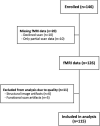Differential neural reward reactivity in response to food advertising medium in children
- PMID: 36816130
- PMCID: PMC9933514
- DOI: 10.3389/fnins.2023.1052384
Differential neural reward reactivity in response to food advertising medium in children
Erratum in
-
Corrigendum: Differential neural reward reactivity in response to food advertising medium in children.Front Neurosci. 2023 Mar 23;17:1170370. doi: 10.3389/fnins.2023.1170370. eCollection 2023. Front Neurosci. 2023. PMID: 37051144 Free PMC article.
Abstract
Introduction: Food cues including food advertisements (ads) activate brain regions related to motivation and reward. These responses are known to correlate with eating behaviors and future weight gain. The objective of this study was to compare brain responses to food ads by different types of ad mediums, dynamic (video) and static (images), to better understand how medium type impacts food cue response.
Methods: Children aged 9-12 years old were recruited to complete a functional magnetic resonance imaging (fMRI) paradigm that included both food and non-food dynamic and static ads. Anatomical and functional images were preprocessed using the fMRIPrep pipeline. A whole-brain analysis and a targeted region-of-interest (ROI) analysis for reward regions (nucleus accumbens, orbitofrontal cortex, amygdala, insula, hypothalamus, ventral tegmental area, substantia nigra) were conducted. Individual neural responses to dynamic and static conditions were compared using a paired t-test. Linear mixed-effects models were then constructed to test the differential response by ad condition after controlling for age, sex, BMI-z, physical activity, and % of kcal consumed of a participant's estimated energy expenditure in the pre-load prior to the MRI scan.
Results: A total of 115 children (mean=10.9 years) completed the fMRI paradigm. From the ROI analyses, the right and left hemispheres of the amygdala and insula, and the right hemisphere of the ventral tegmental area and substantia nigra showed significantly higher responses for the dynamic food ad medium after controlling for covariates and a false discovery rate correction. From the whole-brain analysis, 21 clusters showed significant differential responses between food ad medium including the precuneus, middle temporal gyrus, superior temporal gyrus, and inferior frontal gyrus, and all regions remained significant after controlling for covariates.
Discussion: Advertising medium has unique effects on neural response to food cues. Further research is needed to understand how this differential activation by ad medium ultimately affects eating behaviors and weight outcomes.
Keywords: children; dynamic ad; fMRI; food cues; neural reactivity; static ad; visual stimuli.
Copyright © 2023 Yeum, Jimenez, Emond, Meyer, Lansigan, Carlson, Ballarino, Gilbert-Diamond and Masterson.
Conflict of interest statement
The authors declare that the research was conducted in the absence of any commercial or financial relationships that could be construed as a potential conflict of interest.
Figures




References
-
- Anderson M. (2018). Teens, social media and technology 2018. Pew Research Center: Internet, Science & Tech. Available online at: https://www.pewresearch.org/internet/2018/05/31/teens-social-media-techn... (accessed December 17, 2022).
Grants and funding
LinkOut - more resources
Full Text Sources

